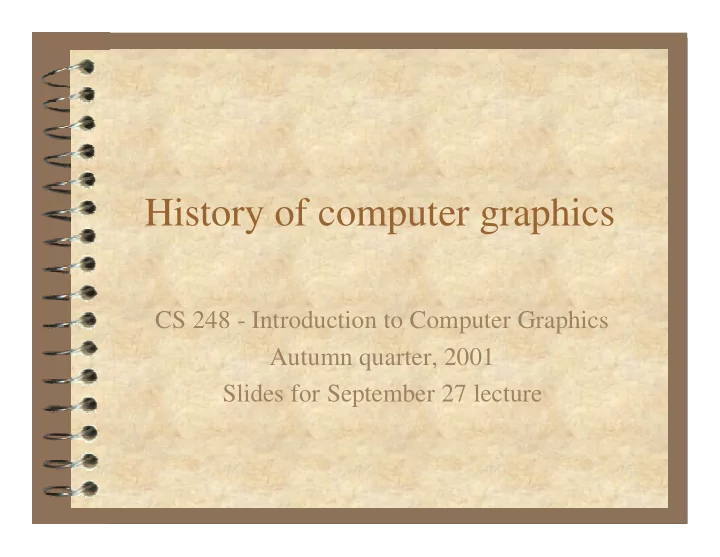

History of computer graphics CS 248 - Introduction to Computer Graphics Autumn quarter, 2001 Slides for September 27 lecture
Ivan Sutherland (1963) - SKETCHPAD pop-up menus constraint-based drawing hierarchical modeling
Display hardware vector displays – 1963 – modified oscilloscope – 1974 – Evans and Sutherland Picture System raster displays – 1975 – Evans and Sutherland frame buffer – 1980s – cheap frame buffers ? bit-mapped personal computers – 1990s – liquid-crystal displays ? laptops – 2000s – micro-mirror projectors ? digital cinema other – stereo, head-mounted displays – autostereoscopic displays – tactile, haptic, sound
Input hardware 2D – light pen, tablet, mouse, joystick, track ball, touch panel, etc. – 1970s & 80s - CCD analog image sensor + frame grabber – 1990s & 2000’s - CMOS digital sensor + in-camera processing ? high-X imaging (dynamic range, resolution, depth of field,…) [Nayar00] ? ?
negative film = 130:1 (7 stops) paper prints = 46:1 [Debevec97] = 250,000:1 (18 stops) ?
Input hardware 2D – light pen, tablet, mouse, joystick, track ball, touch panel, etc. – 1970s & 80s - CCD analog image sensor + frame grabber – 1990s & 2000’s - CMOS digital sensor + in-camera processing ? high-X imaging (dynamic range, resolution, depth of field,…) 3D – 3D trackers – multiple cameras – active rangefinders other – data gloves – voice
Rendering 1960s - the visibility problem – Roberts (1963), Appel (1967) - hidden-line algorithms – Warnock (1969), Watkins (1970) - hidden-surface algorithms – Sutherland (1974) - visibility = sorting
1960s - the visibility problem – Roberts (1963), Appel (1967) - hidden-line algorithms – Warnock (1969), Watkins (1970) - hidden-surface algorithms – Sutherland (1974) - visibility = sorting 1970s - raster graphics – Gouraud (1971) - diffuse lighting – Phong (1974) - specular lighting – Blinn (1974) - curved surfaces, texture – Catmull (1974) - Z-buffer hidden-surface algorithm – Crow (1977) - anti-aliasing
1960s - the visibility problem – Roberts (1963), Appel (1967) - hidden-line algorithms – Warnock (1969), Watkins (1970) - hidden-surface algorithms – Sutherland (1974) - visibility = sorting 1970s - raster graphics – Gouraud (1971) - diffuse lighting – Phong (1974) - specular lighting – Blinn (1974) - curved surfaces, texture – Catmull (1974) - Z-buffer hidden-surface algorithm – Crow (1977) - anti-aliasing
early 1980s - global illumination – Whitted (1980) - ray tracing – Goral, Torrance et al. (1984), Cohen (1985) - radiosity – Kajiya (1986) - the rendering equation
early 1980s - global illumination – Whitted (1980) - ray tracing – Goral, Torrance et al. (1984), Cohen (1985) - radiosity – Kajiya (1986) - the rendering equation late 1980s - photorealism – Cook (1984) - shade trees – Perlin (1985) - shading languages – Hanrahan and Lawson (1990) - RenderMan
early 1990s - non-photorealistic rendering – Drebin et al. (1988), Levoy (1988) - volume rendering – Haeberli (1990) - impressionistic paint programs – Salesin et al. (1994-) - automatic pen-and-ink illustration – Meier (1996) - painterly rendering
early 1990s - non-photorealistic rendering – Drebin et al. (1988), Levoy (1988) - volume rendering – Haeberli (1990) - impressionistic paint programs – Salesin et al. (1994-) - automatic pen-and-ink illustration – Meier (1996) - painterly rendering
The graphics pipeline modeling animation rendering
Modeling polygons constructive solid geometry parametric surfaces implicit surfaces subdivision surfaces particle systems volumes
Animation scripted key-frame interpolation inverse kinematics dynamics
The graphics pipeline the traditional pipeline modeling animation rendering the new pipeline? 3D motion image-based scanning capture rendering
Recommend
More recommend